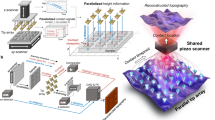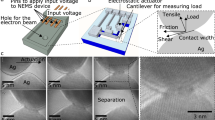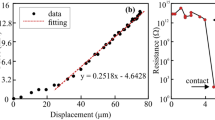Abstract
One approach to ultrahigh-density data storage involves the use of arrays of atomic force microscope probes to read and write data on a thin polymer film, but damage to the ultrasharp silicon probe tips caused by mechanical wear has proved problematic. Here, we demonstrate the effective elimination of wear on a tip sliding on a polymer surface over a distance of 750 m by modulating the force acting on the tip–sample contact. Friction measurements as a function of modulation frequency and amplitude indicate that a reduction of friction is responsible for the reduction in wear to below our detection limit. In addition to its relevance to data storage, this approach could also reduce wear in micro- and nanoelectromechanical systems and other applications of scanning probe microscopes.
This is a preview of subscription content, access via your institution
Access options
Subscribe to this journal
Receive 12 print issues and online access
$259.00 per year
only $21.58 per issue
Buy this article
- Purchase on Springer Link
- Instant access to full article PDF
Prices may be subject to local taxes which are calculated during checkout






Similar content being viewed by others
References
Vettiger, P. et al. The ‘millipede’—nanotechnology entering data storage. IEEE Trans. Nanotechnol. 1, 39–55 (2002).
Pantazi, A. et al. Probe-based ultrahigh-density storage technology. IBM J. Res. Devel. 52, 493–511 (2008).
Hamann, H., O'Boyle, M., Martin, Y. C., Rooks, M. & Wickramasinghe, H. K. Ultra-high-density phase-change storage and memory. Nature Mater. 5, 383–387 (2006).
Cho, Y. et al. Terabit inch−2 ferroelectric data storage using scanning nonlinear dielectric microscopy nanodomain engineering system. Nanotechnology 14, 637–642 (2003).
Tseng, A. A., Notagiacomo, A. & Chen, T. P. Nanofabrication by scanning probe microscope lithography: a review. J. Vac. Sci. Technol. B 23, 877–894 (2005).
Gotsmann, B., Dürig, U., Frommer, J. & Hawker, C. J. Exploiting chemical switching in a Diels–Alder polymer for nanoscale probe lithography and data storage. Adv. Funct. Mat. 16, 1499–1505 (2006).
Bhushan, B., Kwak, K. J. & Palacio, M. Nanotribology and nanomechanics of AFM probe-based data recording technology. J. Phys. Condens. Matter 20, 365207 (2008).
Gotsmann, B. & Lantz, M. A. Atomistic wear in a single asperity sliding contact. Phys. Rev. Lett. 101, 125501 (2008).
Bhushan, B. Introduction to Tribology (Wiley, 2002).
Erdemir, A., Eryilmaz, O. L., Nilufer, I. B. & Fenske, G. R. Surf. Coat. Technol. 133/134, 448–454 (2000).
Chuang, F. Y., Sun, C. Y., Cheng, H. F., Huang, C. M. & Lin, I. N. Enhancement of electron emission efficiency of Mo tips by diamondlike carbon coatings. Appl. Phys. Lett. 68, 1666–1668 (1996).
Mihalcea, C. et al. Fabrication of monolithic diamond probes for scanning probe microscopy applications. Appl. Phys. A 66, S87–S90 (1998).
Ried, R. P., Mamin, H. J. & Rugar, D. J. Air-bearing sliders and plane–plane–concave tips for atomic force microscope cantilevers. Microelectromech. Syst. 9, 52–57 (2000).
Kim, K.-H. et al. Novel ultrananocrystalline diamond probes for high-resolution low-wear nanolithographic techniques. Small 1, 866–874 (2005).
Gnecco, E. & Meyer, E. (Eds.) Fundamentals of Friction and Wear on the Nanoscale (Springer, 2007).
d'Accunto, M. Theoretical approach for the quantification of wear mechanisms on the nanoscale. Nanotechnology 15, 795–801 (2004).
Kopta, S. & Salmeron, M. The atomic scale origin of wear on mica and its contribution to friction. J. Chem. Phys. 113, 8249–8252 (2000).
Giessibl, F. J. Advances in atomic force microscopy. Rev. Mod. Phys. 75, 949–983 (2003).
Sahoo, D. R. et al. On intermittent-contact mode sensing using electrostatically-actuated micro-cantilevers with integrated thermal sensors. Proc. Am. Control Conf. 2034–2039 (2008).
Dinelli, F., Biswas, S. K., Briggs, G. A. D. & Kolosov, O. V. Ultrasound induced lubricity in microscopic contact. Appl. Phys. Lett. 71, 1177–1179 (1997).
Behme, G. & Hesjedal, T. Influence of surface acoustic waves on lateral forces in scanning force microscopies. J. Appl. Phys. 89, 4850–4856 (2001).
Socoliuc, A. et al. Atomic-scale control of friction by actuation of nanometer-sized contacts. Science 313, 207–210 (2006).
Erdemir, A. & Martin, J.-M. (eds) Superlubricity (Elsevier, 2007).
Despont, M. et al. VLSI-NEMS chip for parallel AFM data storage. Sens. Actuat. A 80, 100–107 (2000).
Pozidis, H. et al. Demonstration of thermomechanical recording at 641 Gbit/sq.in. IEEE Trans. Magn. 40, 2531–2536 (2004).
Riedo, E., Gnecco, E., Bennewitz, R., Meyer, E. & Brune, H. Interaction potential and hopping dynamics governing sliding friction. Phys. Rev. Lett. 91, 084502 (2003).
Tambe, N. S. & Bhushan, B. Durability studies of micro/nanoelectromechanical systems materials, coatings and lubricants at high sliding velocities (up to 10 mm s−1) using a modified atomic force microscope. J. Vac. Sci. Technol. A 23, 830–835 (2005).
Acknowledgements
The authors gratefully acknowledge helpful discussions with A. Knoll and U. Duerig, and thank the probe storage team at the Zurich Research Laboratory. In particular, the authors thank H. Rothuizen for assistance with FEM modelling, M. Despont and U. Drechsler for assistance with the cantilevers, R. Pratt and J. Hedrick for the polymer samples, D. Jubin for experimental support, and E. Eleftheriou and P. Seidler for encouragement and support.
Author information
Authors and Affiliations
Corresponding author
Supplementary information
Supplementary information
Supplementary information (PDF 407 kb)
Rights and permissions
About this article
Cite this article
Lantz, M., Wiesmann, D. & Gotsmann, B. Dynamic superlubricity and the elimination of wear on the nanoscale. Nature Nanotech 4, 586–591 (2009). https://doi.org/10.1038/nnano.2009.199
Received:
Accepted:
Published:
Issue Date:
DOI: https://doi.org/10.1038/nnano.2009.199
This article is cited by
-
Active control of friction realized by vibrational excitation: Numerical simulation based on the Prandtl-Tomlinson model and molecular dynamics
Friction (2023)
-
Atomistic observation on diffusion-mediated friction between single-asperity contacts
Nature Materials (2022)
-
Vibration-induced nanoscale friction modulation on piezoelectric materials
Friction (2022)
-
Dynamic friction energy dissipation and enhanced contrast in high frequency bimodal atomic force microscopy
Friction (2022)
-
Structural superlubricity and ultralow friction across the length scales
Nature (2018)



